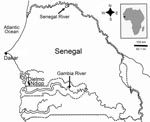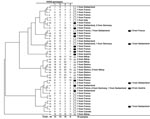Volume 15, Number 6—June 2009
Dispatch
Tropheryma whipplei in Fecal Samples from Children, Senegal
Abstract
We tested fecal samples from 150 healthy children 2–10 years of age who lived in rural Senegal and found the prevalence of Tropheryma whipplei was 44%. Unique genotypes were associated with this bacterium. Our findings suggest that T. whipplei is emerging as a highly prevalent pathogen in sub-Saharan Africa.
Tropheryma whipplei is known mainly as the bacterial pathogen responsible for Whipple disease (1). Until recently, it was thought to be a rare bacterium typically causing disease in white men (1). However, recent studies have shown 1%–11% prevalence of the bacterium in fecal samples from the healthy general adult population in Europe (2,3). T. whipplei also was viable in a fecal sample from a patient with Whipple disease (4). In addition, T. whipplei DNA has been detected in sewage and is more prevalent in fecal samples of sewer workers (12%–26%) than in the general population, supporting this environment as a likely ecologic niche (2,3). T. whipplei was highly prevalent in fecal samples of children 2–4 years of age in France who have gastroenteritis but was not detected in a control group of children of the same age who did not have diarrhea (5).
For these reasons, we speculated that if T. whipplei is transmitted through the fecal–oral route, it might be more prevalent in countries with poor sanitation, such as developing countries. Because no information is available about T. whipplei and Whipple disease in Africa, we conducted a study to assess the prevalence of T. whipplei in fecal samples from healthy children in Senegal, specifically in the villages of Dielmo and Ndiop (Figure 1).
In early April 2008, we sampled fecal specimens from 150 healthy children (79 girls) 2 months–10 years of age (mean 3.5 years ± 2.5 years) living in 2 villages in Senegal (Ndiop, 77 children; Dielmo, 73 children) (6). These villages are included in the Dielmo project, initiated in 1990 for long-term investigations of host–parasite associations in the entire village population, which was enrolled in a longitudinal prospective study (6,7). At the beginning of the current study, parents or legal guardians of all children gave individual informed consent. The national ethics committee of Senegal approved the project (6). Eight wells in the 2 villages (5 from Dielmo, 3 from Ndiop), which are the only sources of drinking water for the communities, also were sampled.
After collection, each fecal specimen was mixed with 2.5 mL of absolute ethanol for storage and transportation to our laboratory at room temperature. On arrival, DNA was extracted by using the BioRobot MDx workstation (QIAGEN, Valencia, CA, USA) in accordance with the manufacturer’s recommendations and protocols. T. whipplei quantitative PCR assays were performed as previously described (8). A case was defined as 2 positive quantitative PCR results in assays targeting 2 different T. whipplei DNA sequences. T. whipplei genotyping using 4 variable sequences was performed by using samples from children with high bacterial loads, as previously reported (9).
Among the 150 healthy children, the prevalence of T. whipplei was 11% (2/18) in children <8 months of age, 37% (10/27) in children 8–24 months of age, and 44% (46/105) in children 2–10 years of age (Figure 1). None of the 8 water wells sampled were positive for T. whipplei.
A complete genotype was obtained from 18 healthy children (Figure 2). We found 10 new genotypes in 3 independent clusters, all of which were unique to Senegal. Four genotypes were detected only in Ndiop and 5 only in Dielmo. One genotype common to both villages was classified as epidemic to Ndiop.
In our study, 44% of children >2 years of age who live in rural Senegal carried T. whipplei. Our requirement for 2 positive test results ruled out sample contamination, and the 4 different PCR amplifications and sequencing reactions used for genotyping resulted in the discovery of novel sequences. This pathogen in Europe, Asia, and America has been reported at much lower prevalences than we found in Senegal (1–3,5). The unique genotypes we discovered in Senegal have not been demonstrated elsewhere through global DNA-based comparisons. This specific type of geographic distribution of genotypes also has been reported for Mycobacterium tuberculosis, for which researchers named genotypes using the same genotyping method (10). Clonal diffusion of a specific genotype within a single area favors a human-to-human transmission hypothesis, which the circulating clones exemplified in Senegal.
In Senegal, children are contaminated with T. whipplei at an early age, and the high carriage rate we observed indicates a potential public health problem. T. whipplei may be responsible for numerous undiagnosed infections, including gastroenteritis, in Africa. The classic form of Whipple disease, characterized by histologic periodic acid-Schiff–stained bacilli in infected small-bowel macrophages, may represent only 1 rare clinical variant of infection that T. whipplei can cause. The higher number of Whipple disease cases in white men may be related to a genetic factor or might reflect a large number of unrecognized cases in developing countries. However, T. whipplei also can cause localized infections, such as endocarditis, spondylodiscitis, meningoencephalitis, and uveitis (1). The bacterium also was detected in a child with pneumonia who resided in the United States (11).
Our study provides evidence that T. whipplei is common in fecal samples from children in Senegal and that local strains circulate in the 2 villages investigated. We suspect T. whipplei infection results directly from human-to-human transmission because water from all 8 village wells tested negative by PCR. T. whipplei is present throughout the world, and specific genotypes often are linked to geographic sources. We speculate that T. whipplei infection might be a major public health concern in sub-Saharan Africa. Additional studies are needed to investigate the role of this extremely common emerging pathogen in developing countries.
Dr Fenollar is a physician and research scientist working at the Unité des Rickettsies. Her main research interests include Tropheryma whipplei and Whipple disease.
Acknowledgments
We thank Sylvain Buffet and Isabelle Combe for their assistance during the studies.
This work was supported by the French Centre National de la Recherche Scientifique.
References
- Fenollar F, Puéchal X, Raoult D. Whipple’s disease. N Engl J Med. 2007;356:55–66. DOIPubMedGoogle Scholar
- Fenollar F, Trani M, Davoust B, Salle B, Birg ML, Rolain JM, Carriage of Tropheryma whipplei in stools of sewer workers and human controls, but not in monkeys and apes. J Infect Dis. 2008;197:880–7. DOIPubMedGoogle Scholar
- Schoniger-Hekele M, Petermann D, Weber B, Muller C. Tropheryma whipplei in the environment—survey of sewage plant influxes and sewage plant workers. Appl Environ Microbiol. 2007;73:2033–5. DOIPubMedGoogle Scholar
- Raoult D, Fenollar F, Birg ML. Culture of Tropheryma whipplei from the stool of a patient with Whipple’s disease. N Engl J Med. 2006;355:1503–5. DOIPubMedGoogle Scholar
- Raoult D, Fenollar F, Li W, Bosdure E, Rolain JM, Richet H, Tropheryma whipplei commonly associated to acute diarrhea in young children. Presented at: 48th Annual Interscience Conference on Antimicrobial Agents and Chemotherapy/46th Annual Meeting of the Infectious Diseases Society of America; October 25–28, 2008; Washington, DC, USA.
- Trape JF, Rogier C, Konate L, Diagne N, Bouganali H, Canque B, The Dielmo project: a longitudinal study of natural malaria infection and the mechanisms of protective immunity in a community living in a holoendemic area of Senegal. Am J Trop Med Hyg. 1994;51:123–37.PubMedGoogle Scholar
- Vial L, Diatta G, Tall A, Ba el H, Bouganali H, Durand P, et al. Incidence of tick-borne relapsing fever in west Africa: longitudinal study. Lancet. 2006;368:37–43. DOIPubMedGoogle Scholar
- Fenollar F, Laouira S, Lepidi H, Rolain J, Raoult D. Value of Tropheryma whipplei quantitative PCR assay for the diagnosis of Whipple’s disease—usefulness of saliva and stool specimens for first line screening. Clin Infect Dis. 2008;47:659–67. DOIPubMedGoogle Scholar
- Li W, Fenollar F, Rolain JM, Fournier PE, Feurle GE, Müller C, Genotyping reveals a wide heterogeneity of Tropheryma whipplei. Microbiology. 2008;154:521–7. DOIPubMedGoogle Scholar
- Djelouadji Z, Arnold C, Gharbia S, Raoult D, Drancourt M. Multispacer sequence typing for Mycobacterium tuberculosis genotyping. PLoS One. 2008;3:e2433. DOIPubMedGoogle Scholar
- Harris JK, De Groote MA, Sagel SD, Zemanick ET, Kapsner R, Penvari C, Molecular identification of bacteria in bronchoalveolar lavage fluid from children with cystic fibrosis. Proc Natl Acad Sci U S A. 2007;104:20529–33. DOIPubMedGoogle Scholar
Figures
Cite This ArticleTable of Contents – Volume 15, Number 6—June 2009
| EID Search Options |
|---|
|
|
|
|
|
|


Please use the form below to submit correspondence to the authors or contact them at the following address:
Didier Raoult, Unité des Rickettsies, URMITE CNRS-IRD UMR 6236, Faculté de Médecine, 27 Bd Jean Moulin, 13385 Marseille, France
Top